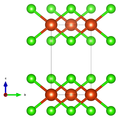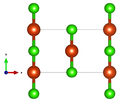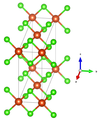Tolbachite
| Tolbachite | |
|---|---|
| General and classification | |
| other names |
IMA 1982-067 |
| chemical formula | CuCl 2 |
|
Mineral class (and possibly department) |
Halides |
|
System no. to Strunz and to Dana |
3.AB.05 09.02.08.02 |
| Crystallographic Data | |
| Crystal system | monoclinic |
| Crystal class ; symbol | monoclinic prismatic; 2 / m |
| Space group | C 2 / m (No. 12) |
| Lattice parameters |
a = 6.90 Å ; b = 3.30 Å; c = 6.82 Å β = 122.3 ° |
| Formula units | Z = 2 |
| Physical Properties | |
| Mohs hardness | not defined |
| Density (g / cm 3 ) | calculated: 3.42 |
| Cleavage | completely after (001) |
| colour | brown to golden brown |
| Line color | not defined |
| transparency | translucent |
| shine | Pearlescent |
| Other properties | |
| Chemical behavior | easily soluble in water |
Tolbachite is a very seldom occurring mineral from the mineral class of " halides " with the chemical composition CuCl 2 and thus, chemically speaking, a copper (II) chloride .
Tolbachite crystallizes in the monoclinic crystal system and develops translucent crystals up to about 2 mm in size in felt-like or moss-like mineral aggregates as well as crusty coatings of brown to golden-brown color and mother-of-pearl-like sheen on the surfaces.
Etymology and history
Tolbachite was discovered in the fumarole products on the Tolbatschik volcano , more precisely on its first cinder cone, on the Kamchatka peninsula in the Russian federal district of Far East . The mineral samples containing the newly discovered mineral were collected from the northern breakthrough during the great 1975-1976 eruption. After the mineral was examined and recognized by the International Mineralogical Association (internal entry number of the IMA: 1982-067 ), the first description was published in 1983 by LP Vergasova and SK Filatov (Russian: Л. П. Вергасова and С. К. Филатов ), who named it after its type locality .
The type material of the mineral is in the museum of the St. Petersburg Mining Institute under the collection no. 1290/1 kept.
classification
Since tolbachite was only recognized as an independent mineral in 1982, it is not yet listed in the 8th edition of the Strunz mineral classification, which has been outdated since 1977 . Only in the Lapis mineral directory , which was revised and updated in 2018 by Stefan Weiß, which is still based on this classic system from Karl Hugo Strunz out of consideration for private collectors and institutional collections , the mineral received the system and mineral number. III / A.07-30 . In the "Lapis Classification", this corresponds to the class of "halides" and then the department "Simple halides" where Tolbachit with Chloromagnesit , Lawrencit and Scacchit forms an independent but unnamed group.
The 9th edition of Strunz's mineral systematics, which has been valid since 2001 and updated by the IMA until 2009, also assigns tolbachite to the “halides” class, although there is a more finely divided section “simple halides without H 2 O”. This is further subdivided according to the molar ratio of metal (M) to the corresponding halogen (X), so that the mineral can be found according to its composition in the sub-section "M: X = 1: 2", where it is the only member of the unnamed Group 3.AB.05 forms.
The systematics of minerals according to Dana , which is mainly used in the English-speaking world , assigns tolbachite to the class and division of the same name of "halides". Here it can be found together with eriochalcite in the unnamed group 09.02.08 within the sub-section "Anhydrous and water-containing halides with the formula AX 2 ".
Chemism
The idealized (theoretical) composition of tolbachite (CuCl 2 ) consists of 47.26% copper (Cu) and 52.74% chlorine (Cl). The analysis of a water extract from the Tolbatschik type material also showed small proportions of zinc (0.30% ZnO), lead (0.11% PbO), sodium (0.74% Na 2 O), potassium (1.50% K. 2 O), sulfur (4.24% SO 4 ) and water of crystallization (H 2 O).
Crystal structure
Tolbachite crystallizes monoclinically in the space group C 2 / m (space group no. 12) with the lattice parameters a = 6.90 Å ; b = 3.30 Å; c = 6.82 Å and β = 122.3 ° and two formula units per unit cell .
The crystal structure of tolbachite consists of CuCl 4 assemblies that form planar squares and are linked by common edges to form chains parallel to the b-axis [010]. These chains form parallel layers (001) via shared corners of the square planes.
| Crystal structure of tolbachite |
|
|
| Color table: __ Cu __ Cl |
properties
Tolbachite can be easily dissolved in cold water. In addition, tolbachite is hygroscopic and therefore able to extract water from its ambient air. It therefore quickly transforms in air to eriochalcite (CuCl 2 · 2H 2 O) with orthorhombic symmetry .
Education and Locations
At its type locality, tolbachite was formed directly from the volcanic gases and was found as incrustations on the basaltic edges of the fumaroles . The accompanying minerals included chalcocyanite , dolerophanite , euchlorin , melanothallite and tenorite .
Tolbachite is one of the very rare mineral formations known in only a few samples from only five documented sites (as of 2019). Besides its type locality, the first cinder mineral resigned on Tolbachik still at the fumarole Jadowitaja on the second cinder cone and the large column breakage. Tolbachite is one of the most important copper minerals of the fumaroles on the northern breakthrough.
Tolbachite was also found in the Cueva Los Minerales at the Irazú volcano in Costa Rica (Cartago Province) and in the Southwest Mine near Bisbee in Cochise County in the US state of Arizona.
See also
literature
- Л. П. Вергасова, С. К. Филатов: Новьій Минерал Толбачит CuCl 2 . In: Доклады Академии Наук СССР . tape 270 , no. 2 , 1983, p. 415–417 (Russian, rruff.info [PDF; 1.9 MB ; accessed on November 12, 2019] English transcription: LP Vergasova, SK Filatov: New mineral tolbachite CuCl 2 . in: Doklady Akademii Nauk SSSR ).
- PC Burns, FC Hawthorne: Tolbachite, CuCl 2 , the first example of Cu 2+ octahedrally coordinated by Cl - . In: American Mineralogist . tape 78 , 1993, p. 187–189 (English, rruff.info [PDF; 363 kB ; accessed on November 12, 2019]).
- Pete J. Dunn, LJ Cabri, GY Chao, M. Fleischer, CA Francis, JD Grice, John Leslie Jambor , Adolf Pabst : New mineral names . In: American Mineralogist . tape 69 , 1984, pp. 406-412 (English, rruff.info [PDF; 684 kB ; accessed on November 12, 2019]).
- Igor V. Pekov: Minerals first discovered on the territory of the former Soviet Union . 1st edition. Ocean Pictures, Moscow 1998, ISBN 5-900395-16-2 , pp. 213, 326 .
Web links
- Mineral Atlas: Tolbachite (Wiki)
- Tolbachite. In: mindat.org. Hudson Institute of Mineralogy, accessed November 2, 2019 .
- David Barthelmy: Tolbachite Mineral Data. In: webmineral.com. Retrieved November 2, 2019 .
- American-Mineralogist-Crystal-Structure-Database - Tolbachite. In: rruff.geo.arizona.edu. Retrieved November 8, 2019 .
Individual evidence
- ↑ a b Malcolm Back, William D. Birch, Michel Blondieau and others: The New IMA List of Minerals - A Work in Progress - Updated: September 2019. (PDF 2672 kB) In: cnmnc.main.jp. IMA / CNMNC, Marco Pasero, September 2019, accessed November 2, 2019 .
- ↑ a b c d e Hugo Strunz , Ernest H. Nickel : Strunz Mineralogical Tables. Chemical-structural Mineral Classification System . 9th edition. E. Schweizerbart'sche Verlagbuchhandlung (Nägele and Obermiller), Stuttgart 2001, ISBN 3-510-65188-X , p. 152 (English).
- ↑ a b c d e f Tolbachite . In: John W. Anthony, Richard A. Bideaux, Kenneth W. Bladh, Monte C. Nichols (Eds.): Handbook of Mineralogy, Mineralogical Society of America . 2001 (English, handbookofmineralogy.org [PDF; 71 kB ; accessed on November 2, 2019]).
- ^ A b Pete J. Dunn, LJ Cabri, GY Chao, M. Fleischer, CA Francis, JD Grice, John Leslie Jambor , Adolf Pabst : New mineral names . In: American Mineralogist . tape 69 , 1984, pp. 406-412 (English, rruff.info [PDF; 684 kB ; accessed on November 12, 2019]).
- ^ A b Igor V. Pekov: Minerals first discovered on the territory of the former Soviet Union . 1st edition. Ocean Pictures, Moscow 1998, ISBN 5-900395-16-2 , pp. 213, 326 .
- ↑ Catalog of Type Mineral Specimens - T. (PDF 87 kB) In: docs.wixstatic.com. Commission on Museums (IMA), December 12, 2018, accessed November 12, 2019 .
- ↑ Stefan Weiß: The large Lapis mineral directory. All minerals from A - Z and their properties. Status 03/2018 . 7th, completely revised and supplemented edition. Weise, Munich 2018, ISBN 978-3-921656-83-9 .
- ↑ Ernest H. Nickel, Monte C. Nichols: IMA / CNMNC List of Minerals 2009. (PDF 1703 kB) In: cnmnc.main.jp. IMA / CNMNC, January 2009, accessed November 2, 2019 .
- ^ Hugo Strunz , Ernest H. Nickel : Strunz Mineralogical Tables. Chemical-structural Mineral Classification System . 9th edition. E. Schweizerbart'sche Verlagbuchhandlung (Nägele and Obermiller), Stuttgart 2001, ISBN 3-510-65188-X , p. 156 (English).
- ↑ Localities for Tolbachite. In: mindat.org. Hudson Institute of Mineralogy, accessed November 13, 2019 .
- ↑ List of locations for tolbachite in the Mineralienatlas and Mindat , accessed on November 2, 2019.




